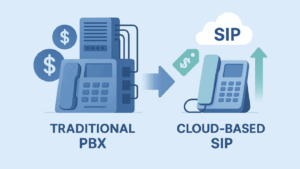
All About Cloud Voice SIP: Understanding Session Initiation Protocol
Introduction to Cloud Voice SIP
Struggling with a complex and outdated phone system? Do frequent failures interrupt crucial communication in your organization? You’re not alone. Many small to medium-sized businesses grapple with the challenges of traditional telephony systems. They’re often expensive, rigid, and difficult to scale – not an ideal situation when flexibility is crucial to your business’s success. The solution? Cloud Voice SIP.
Cloud Voice Session Initiation Protocol (SIP) is an innovative technology that uses Voice over IP (VoIP) to convert a traditional ISDN PBX to VoIP via a SIP gateway. What’s the result? A streamlined, scalable, and efficient communication system that takes business communication to entirely new heights.
So, how does Cloud Voice SIP play a role in modern communication? With digital transformation now the norm, Cloud Voice SIP is rapidly becoming the go-to solution for businesses around the world. It pairs seamlessly with VoIP technology and, unlike traditional phone systems, it’s not limited by physical constraints. Instead, it paves the way for a broader range of capabilities, transforming not just voice calls, but integrating with cloud-based telephony to bring together a myriad of communication channels.
Sounds promising, right? But before you get too excited, let’s define some key terms:
- Voice over IP (VoIP): This system transmits voice data over the internet, transforming phone calls into digital data. It can function on its own but provides optimal results when integrated with SIP.
- ISDN PBX: This is a conventional, physical Private Branch Exchange system that enables Voice over ISDN (Integrated Services Digital Network).
- SIP Gateway: This device acts as a connector between traditional phone systems and digital VoIP services. It converts analog voice signals into the digital signals required for VoIP.

In a nutshell, Cloud Voice SIP is a top contender for efficient, scalable, and modern business communication. Through cloud-based telephony and a protocol like SIP, businesses can shed the physical constraints of traditional systems and unleash a whole new universe of communication possibilities. Stay with us as we delve into the nuances of this game-changing technology and how you can leverage it for your business.
Understanding the Basics of SIP
SIP, or Session Initiation Protocol, is a vital cog in the machinery of modern communication. Whether you’ve heard about it in passing or are considering integrating it into your business operations, understanding SIP can help you leverage its full potential.
What is SIP?
Session Initiation Protocol, or SIP, is a set of rules that governs the exchange of multimedia communication sessions. In simpler terms, SIP is the protocol that enables devices to communicate with each other over the internet. It’s the technology behind VoIP (Voice over Internet Protocol), allowing voice calls and messages to be sent over internet networks.
However, it’s crucial to note that SIP and VoIP are distinct technologies. While VoIP is the ability to make voice calls and send messages over internet networks, SIP is the technology that makes VoIP possible. SIP’s role is to initiate and terminate data transfer between two or more communication devices. It’s the preferred method for VoIP and in-app communication, connecting devices over the internet to share voice, video, instant messages, files, and other multimedia communication sessions.
How SIP Works in Voice Communication
In a traditional phone system, connections are made via a Public Switched Telephone Network (PSTN), a complex web of physical lines and exchanges. This system is limited by the number of physical connections it can handle, making it less flexible and scalable.
In contrast, SIP works by eliminating the need for a middleman when connecting your business to the rest of the world. It leverages the vast capacity of your existing internet connection, be it home Wi-Fi or enterprise broadband connection. SIP establishes a SIP trunk (or a virtual phone line) over your current internet connection, bypassing traditional phone lines and connecting directly to the PSTN.
SIP creates a virtual bridge between the caller and the receiver over the internet. It initiates the communication session, maintains it during the call, and then terminates it once the call is over. This process is done in a secure, efficient manner, making internet calling cheap, quick, and secure.
SIP technology also provides trunking, allowing an organization to route traffic from multiple devices using a single trunk. This means SIP trunking is limited only by the number of channels provisioned on demand, rather than the number of costly physical lines to a PSTN. The result is improved scalability and cost-efficient communication and collaboration.
In the next section, we’ll compare SIP and Cloud PBX to help you understand the key differences and decide which could be the best fit for your business.
The Difference Between SIP and Cloud
When it comes to modern business communication, there’s often confusion about the difference between SIP (Session Initiation Protocol) and Cloud PBX. While both are integral to VoIP (Voice over IP) technology, they serve different purposes. Let’s delve into each of these technologies to better understand how they function.
Explanation of Cloud PBX
Cloud PBX, also known as a cloud-based phone system, is hosted by your service provider. Unlike traditional PBX systems that require on-site hardware, Cloud PBX operates over the internet, delivering voice or video over data networks. As a result, you can access your phone system from anywhere, as long as you have an internet connection.
The primary advantage of a Cloud PBX is that it eliminates the need for costly hardware and maintenance. Since the system is hosted by the service provider, they handle all updates and regular maintenance. This shift from on-premise hardware to cloud-based systems offers businesses a more scalable and flexible communication solution.
Explanation of SIP Trunking
SIP Trunking, on the other hand, is a protocol that connects your on-premise PBX to the internet. SIP Trunking is a virtual phone line that uses your data network to transport voice, video, and unified communications services. Unlike traditional phone lines that limit the number of calls based on the number of physical lines, SIP Trunking allows for virtually unlimited simultaneous calls.
The main advantage of SIP Trunking is that it allows businesses to leverage their existing PBX hardware. This means if your organization has already invested in a PBX, then SIP Trunking can enhance that existing investment by adding the benefits of VoIP.
Comparing Cloud PBX and SIP Trunking
The fundamental difference between Cloud PBX and SIP Trunking lies in where the phone system is hosted and how it connects to the internet. Cloud PBX is hosted by your service provider and accessed over the internet, while SIP Trunking connects your physical, on-premise PBX to the internet.
When it comes to hardware costs, a Cloud PBX solution saves you on initial startup costs, as your provider hosts and maintains the PBX itself. Meanwhile, SIP Trunking would be costly upfront if you didn’t already own a PBX. However, if your organization already has a PBX, then SIP Trunking is an economically sound choice.
In terms of maintenance, Cloud PBX is maintained by your provider, while SIP Trunking requires maintenance from your internal IT staff. This means you’ll need internal expertise on hand for SIP Trunking, which is another cost factor to consider.
Deciding between Cloud PBX and SIP Trunking ultimately comes down to your existing infrastructure and needs. If you already own a SIP-enabled PBX, then SIP Trunking is a logical choice. But if you don’t have a PBX or your system is outdated, a Cloud PBX solution is right for you.
At SIP.US, we offer both Cloud Voice SIP and SIP Trunking solutions, helping you make the most of your business communications. Our team is dedicated to guiding you toward the best solution for your unique needs.
Advantages of Using Cloud Voice SIP
After understanding the basics of Session Initiation Protocol (SIP) and how it differs from Cloud PBX, it’s time to delve into the key benefits of using cloud voice SIP. This innovative approach to business communication offers unparalleled advantages, ranging from enhanced flexibility to cost optimization.
Enhanced Flexibility and Scalability
One of the biggest advantages of cloud voice SIP is its flexibility. Unlike traditional telephony systems that are bound by physical infrastructure, SIP allows for seamless connection across multiple cloud platforms. This means that as your business grows, you can easily scale your voice services based on demand, without the need for large hardware investments.
Furthermore, cloud voice SIP supports a range of devices, from SIP devices to mobile phones, ensuring that your communication infrastructure adapts to your ever-changing business requirements. With us at SIP.US, you’ll have the freedom to design a communication network that aligns with your specific needs.
Redundancy and Resilience
Any disruption in communication can have a significant impact on business operations. That’s where the inherent redundancy of cloud voice SIP comes in. By distributing voice services across multiple cloud providers, you can significantly enhance the resilience of your communication network. In the event of a service disruption, traffic can be rerouted to another provider, ensuring continuous communication and minimizing downtime.
Global Reach and Reduced Latency
Are you operating on a global scale? Cloud voice SIP has an edge here too. It allows you to position your voice services closer to your end-users, regardless of their geographical location. This results in reduced latency and ensures high-quality communication experiences, a critical factor for businesses seeking to provide exceptional customer service.
Cost Optimization
Switching to cloud voice SIP can result in significant cost savings. Traditional telephony systems often come with high infrastructure and maintenance costs. In contrast, cloud voice SIP leverages the pay-as-you-go model of cloud services. This means you only pay for what you use, avoiding unnecessary expenses associated with overprovisioned infrastructure. With cloud voice SIP, you can optimize costs based on actual usage.
Integration with Unified Communications Platforms
Cloud voice SIP is not just about voice communication. It also integrates seamlessly with Unified Communications (UC) platforms. This allows you to combine voice, video, messaging, and collaboration tools into a single interface, enhancing employee productivity and fostering efficient communication across your organization. So, whether you’re looking to connect teams across different locations or streamline business processes, cloud voice SIP can help you achieve your goals.
At SIP.US, we’re committed to helping businesses unlock the full potential of cloud voice SIP. We understand that every business is unique, and that’s why we offer customized solutions tailored to your specific needs. With our expertise and commitment to customer satisfaction, we’re confident that we can help you transform your business communication and prepare for the future.
Practical Applications of Cloud Voice SIP
Cloud voice SIP is not just a concept—it’s a powerful tool with practical applications that can revolutionize the way organizations communicate. From government departments to businesses and collaborative platforms like Microsoft Teams, the benefits of cloud voice SIP extend far and wide.
Cloud Voice SIP in Government Organizations
In the fast-paced and interconnected world of modern government operations, communication is the linchpin that holds everything together. Government departments are continually striving for flexibility, scalability, and resilience in their operations. That’s where cloud voice SIP comes in, offering a game-changing solution.
By enabling organizations to break free from the constraints of traditional telephony systems, cloud voice SIP allows for seamless connectivity across multiple cloud platforms. This flexibility ensures dynamic scaling of voice services based on demand, enhancing flexibility and reducing the need for extensive hardware investments. Moreover, by distributing voice services across multiple cloud providers, it enhances resilience, enabling traffic to be rerouted in case of service disruption, ensuring continuous communication.
Cloud Voice SIP in Business Communication
In the business world, the ability to adapt and respond quickly to changing needs is crucial. Cloud voice SIP provides a cost-effective alternative to traditional telephony systems by leveraging the pay-as-you-go model of cloud services. Businesses can optimize costs by scaling their voice services based on actual usage, avoiding unnecessary expenses related to overprovisioned infrastructure.
Additionally, cloud voice SIP integrates seamlessly with Unified Communications (UC) platforms, creating a unified and cohesive communication environment. This integration allows businesses to combine voice, video, messaging, and collaboration tools into a single, streamlined interface, enhancing employee productivity and fostering efficient communication across the organization.
Cloud Voice SIP and Microsoft Teams Integration
As a growing number of businesses start to use collaborative platforms like Microsoft Teams, having robust and reliable voice communication becomes increasingly important. SIP calling integration with cloud-based telephony allows businesses to link their phone systems directly with customer relationship management (CRM) software. This setup can significantly enhance the clarity of business relationship records and improve customer service.
Whether your team is in the office or working remotely, cloud voice SIP ensures that everyone is connected, collaborating, and communicating effectively. It provides a practical, feature-rich, and efficient solution for modern communication needs.
At SIP.US, we understand the power of cloud voice SIP and its potential to revolutionize communication in various sectors. We’re committed to providing advanced and reliable cloud SIP services to help you unlock these benefits for your organization.
Choosing the Right Cloud Voice SIP Solution
After understanding the role of Cloud Voice SIP in modern communication and its various applications, the next step is to identify the right solution for your business.
Factors to Consider When Choosing Between SIP Trunking and Cloud PBX
There are several factors to consider when deciding between SIP Trunking and Cloud PBX.
1. Scalability: One of the significant advantages of Cloud PBX is its scalability. It’s simple to add phone lines if new team members are hired. On the other hand, SIP trunking is more suitable for businesses with a stable number of users.
2. Cost: SIP Trunking tends to be more cost-effective for larger businesses with high call volumes, while Cloud PBX may be more affordable for small businesses.
3. Control: If you prefer to have full control over your phone system, then SIP Trunking might be the better option for you. It gives you more control over your user interface and the ability to add or change service.
4. Mobility: Cloud PBX is particularly beneficial if your business has remote workers as it allows forwarding calls to mobile devices and accessing advanced voicemail, faxes, and business SMS.
5. Integration: Integration with other services you currently use is a critical factor. Cloud PBX often provides better integration options with third-party services.
Before deciding, evaluate your current and future needs and understand how each solution aligns with those needs.
How SIP.US Can Help in Choosing the Right Solution
At SIP.US, we understand that every business is unique and has different communication needs. Therefore, we aim to provide a solution that is tailored to your specific requirements.
We offer both SIP trunking and Cloud PBX solutions, giving you the flexibility to choose the option that best fits your business. Our team of experts is always ready to guide you through the process and help you make an informed decision.
In conclusion, whether you opt for SIP Trunking or Cloud PBX, choosing a cloud voice SIP solution can have significant benefits for your business. Not only does it provide advanced features and flexibility, but it can also help you reduce costs and improve efficiency. Therefore, it’s worth taking the time to evaluate your options and choose the solution that’s right for you.
Conclusion: The Future of Cloud Voice SIP
As we navigate the rapidly evolving digital landscape, the role of cloud voice SIP is becoming increasingly crucial. It’s not just about making calls over the internet anymore; it’s about revolutionizing how we communicate and collaborate in the digital age.
The Shift from Voice to Collaboration
Communication today is no longer limited to voice calls. It has evolved to include video, messaging, and collaboration tools, all integrated into a single, streamlined interface. This shift from voice to collaboration is greatly facilitated by cloud voice SIP, which allows seamless integration with Unified Communications (UC) platforms. This integration enhances employee productivity, fosters efficient communication across the organization, and can even extend to customer interactions.
SIP to SIP multi-cloud voice, for instance, is unlocking unparalleled advantages, from enhanced flexibility and global reach to cost optimization. It’s redefining how we connect, collaborate, and solve problems, extending beyond traditional telephony systems.
The Role of Cloud Voice SIP in Future-proofing Communication Infrastructure
As businesses continue to adapt to the demands of the digital era, cloud voice SIP emerges as a strategic solution to future-proof communication infrastructure. The integration of 5G networks is projected to significantly boost the VoIP/SIP market, offering higher definition video content, faster loading speeds, and improved connectivity. This will further enhance the capabilities of cloud voice SIP, reducing dropped calls and boosting productivity.
Furthermore, the advent of technologies like SIP Trunking allows businesses to leverage the power of the internet to connect their existing phone systems, enabling more efficient and cost-effective communication.
At SIP.US, we understand the importance of staying ahead of the curve and are committed to providing businesses with the tools they need to harness the power of cloud voice SIP. We believe that the future of SIP calling is not only bright but also boundless and exciting, promising a more connected and efficient world.
In conclusion, cloud voice SIP is much more than a technology for voice communication – it’s a comprehensive solution for modern, digital-age communication. Its advantages extend far beyond cost savings, offering businesses the flexibility, scalability, and resilience they need to thrive in today’s interconnected business landscape. By embracing cloud voice SIP, businesses can ensure their communication infrastructure is ready for the future.



